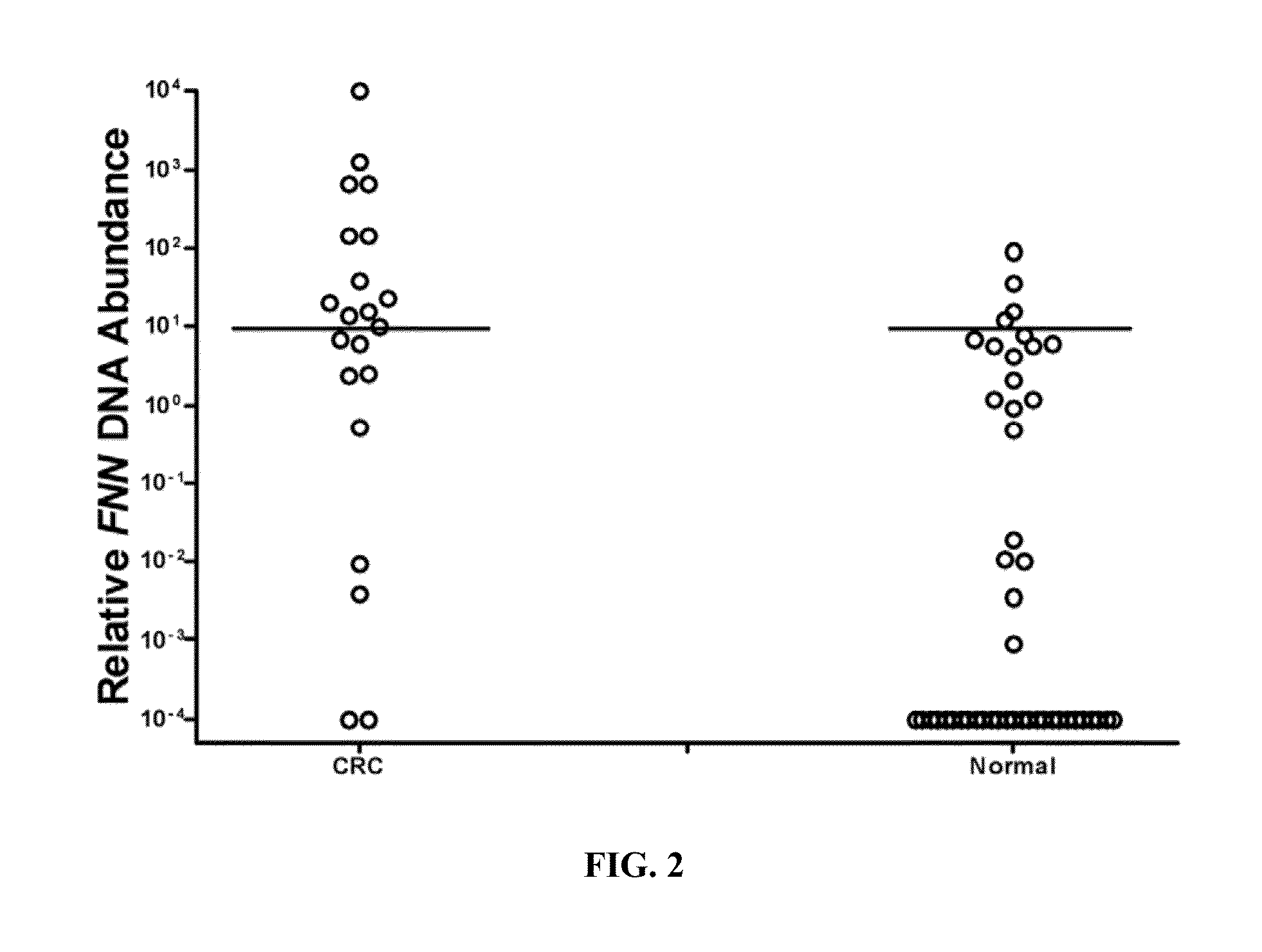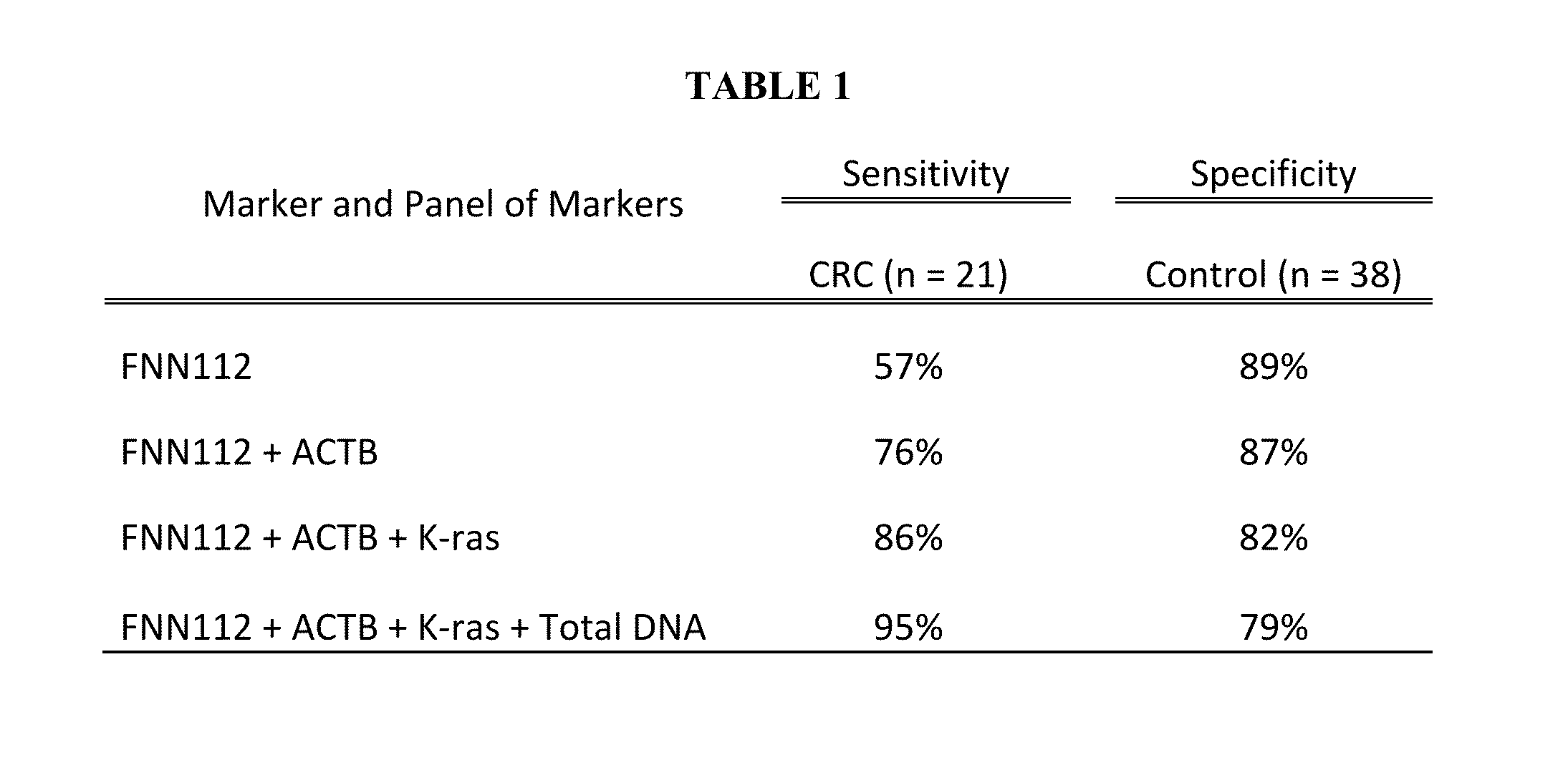Methods and materials for quantification of fusobacterium nucleatum DNA in stool to diagnose colorectal neoplasm
a colorectal neoplasm and fusobacterium nucleatum technology, applied in the direction of microbiological testing/measurement, biochemistry apparatus and processes, etc., can solve the problems of small harm risk, marginal screening accuracy, and invasive instrumentation, so as to improve the diagnosis
- Summary
- Abstract
- Description
- Claims
- Application Information
AI Technical Summary
Benefits of technology
Problems solved by technology
Method used
Image
Examples
example 1
[0063]We first tested whether a positive detection (qualitative detection) of FNN in stool indicates the presence of CRC. FNN DNA originated from other organs can survive and get into stool. In other words, if FNN is present in other organ tissues (even if it is colon-tumor specific), the stool collected from those without CRC may contain FNN as well.
[0064]Stool samples collected from 38 patients without CRC were studied. FIG. 1 displays the number of positive detection of FNN DNA from the stools of the controls without CRC by qPCR. As shown in FIG. 1, FNN DNA was positively detected from 28 out of 38 stool samples (73%) when 32 μg equivalent stool DNA were input into qPCR, and 32 out of the 38 stool samples (84%) when 800 μg equivalent stool DNA was input into qPCR, respectively. This result confirmed our concerns that the stool collected from a large percentage of the subjects without CRC could contain FNN DNA as well, and that a positive detection (qualitative detection) of FNN D...
example 2
[0068]Considering the result of Experiment 1 that a positive detection (qualitative detection) of FNN DNA from stool cannot distinguish the CRC patients from those without CRC, in this study, we used qPCR to quantify FNN DNA in a given amount of the stool samples collected from 21 patients with CRC (21 stool samples) and 38 controls without CRC. The 112bp FNN DNA fragment was amplified.
[0069]We normalized the quantity of FNN DNA against the unit weight of stool and discovered that this normalization strategy yielded the best results for CRC screening with the tested samples (as shown in TABLE 1).
[0070]We measured the relative abundance of FNN DNA among all stool samples and determined the cutoff threshold of the relative abundance that can distinguish CRC patients from those without CRC. Experimentally, for each stool sample, 32 μg stool equivalent of DNA were input into qPCR. The amount of DNA presented in stool were determined and represented in cycle threshold (Ct) numbers. We as...
example 3
[0075]No single marker can yield a perfect detection for CRC screening and a panel of markers may yield a better sensitivity. The quantity of FNN DNA / per unit stool weight is a specific marker with a sensitivity of better than 55%, making it an ideal anchor marker to be used with others to form a marker panel.
[0076]The markers studied along with FNN DNA were the quantity of human DNA / per unit stool weight, the quantity of total DNA / per unit stool weight, and k-ras mutations. We first combined quantity of FNN DNA with quantity of human DNA to form a duo-marker panel. As seen from TABLE 1, the sensitivity increased to 76% with this duo-marker panel from 57% when only quantification of FNN DNA was used as the marker, while the specificity slightly decreased to 87% from 89%. Then we added the k-ras mutations to the marker panel, leading to improvement of the detection sensitivity to 86% with a specificity of 82%. Finally, we added total stool DNA to the marker panel, the sensitivity inc...
PUM
| Property | Measurement | Unit |
|---|---|---|
| Weight | aaaaa | aaaaa |
| Threshold limit | aaaaa | aaaaa |
Abstract
Description
Claims
Application Information
 Login to View More
Login to View More - R&D
- Intellectual Property
- Life Sciences
- Materials
- Tech Scout
- Unparalleled Data Quality
- Higher Quality Content
- 60% Fewer Hallucinations
Browse by: Latest US Patents, China's latest patents, Technical Efficacy Thesaurus, Application Domain, Technology Topic, Popular Technical Reports.
© 2025 PatSnap. All rights reserved.Legal|Privacy policy|Modern Slavery Act Transparency Statement|Sitemap|About US| Contact US: help@patsnap.com



